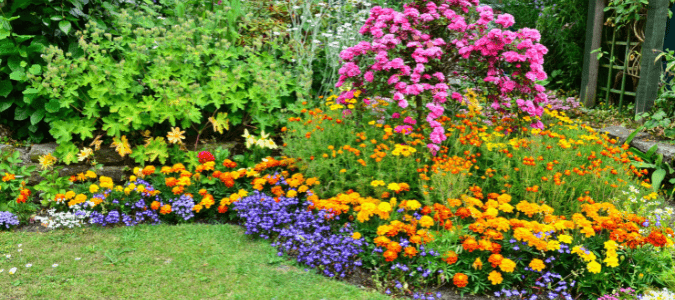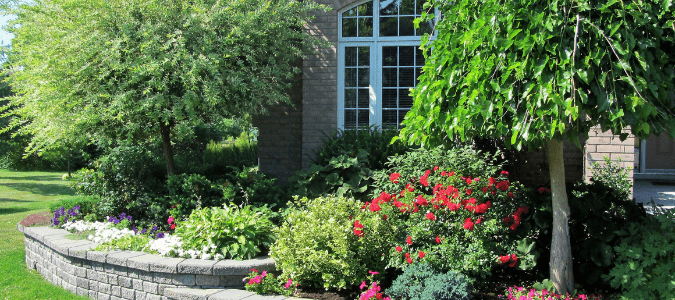Getting Started
- Take care of weeds first, before planting flowers. If you want a low-maintenance flower bed, keep in mind that doing a bit more work up front will save you lots of labor later on. This is especially true when it comes to weeds. When planting a new flower bed, it can take significant time and labor to dig up all the grass, weeds and other vegetation, but it’s worth the effort in the long run. Also, don’t forget the weed-blocking power of mulch! Mulch is one of the last steps, as it should be applied after you’ve planted your garden bed. It will help prevent weeds from growing, and it also has other benefits. It can keep moisture in, and protect your plants from both heat and cold. Refreshing mulch annually is a great way to keep retaining its benefits for your garden.
- Choose the right flowers for your yard and region. A great first step in creating a low-maintenance flower bed is choosing plants that are easy to care for. It helps to focus on plants that are already adapted to your region’s climate. For example, if you live in a warmer region without much rainfall, growing tropical flowers requires more watering and other work to keep them healthy. If you choose flowering plants that are native to the area, they can more easily withstand hot, dry periods. Another consideration is how much sunlight your yard gets every day. If you have a shady, tree-filled yard, you’ll want to look for flowering plants that don’t need a lot of sun to thrive. Similarly, if your yard is very sunny, look for plants that can tolerate many hours of sun and heat every day. Your local plant nursery or garden center is a great place to ask questions and find plants that will do well in your particular yard and area.
Designing Your Flower Bed
- Go for a simple design. Trying to incorporate too many different elements into your garden design not only makes installing it more work. It also means you might be mixing together too many different flowers or plants that have different needs as far as sunlight, water and soil nutrients. Keep it simple instead: Select a few plants you like that look good together, and plant several of each in your garden bed. Just one garden bed with flowers will provide a nice pop of color, or you can plan for two or three beds in different parts of the yard for some variety.
You can still keep your garden design simple while considering a mixture of perennials, annuals and non-flowering plants. Native grasses also add wonderful texture and interest. As long as everything planted in one garden bed has similar watering and sunlight needs, you can play around with what you group together to create a beautiful garden space. You can also consider factors like how close your plants are to the garden hose or the house as you plan your design. If you’re planting things that will need more regular watering, it’s a good idea to plant them near the house or the water source, to make this task easier to do regularly. - Consider adding edging to your flower bed. Landscape edging helps keep your newly planted garden bed from sprawling into the rest of your yard, and vice versa. It also just looks nice, adding definition to the space. Landscape edging comes in many different forms and materials, ranging from wood to rubber, metal or stone. If your garden bed has straight lines, you might want to use steel or aluminum edging. Rubber edging is flexible, which makes it work well for straight or curved garden borders. Natural stones are another great, low-maintenance choice for a border that can be either straight or curved.
Setting Up a New Flower Bed
For people who enjoy gardening, setting up a new flower bed can be a labor of love—emphasis on the word “labor.” It can be a lot of work, especially at the beginning, when you’re trying to clear the spot, choose the right plants and design, and get everything in the ground just so. Adding edging and mulch to finish it off is just the beginning. Then you have to keep up with weeding, watering and more!
Planting Flower Beds Around Trees
Many types of grass have a hard time growing underneath trees. Grass typically needs lots of sunlight, and the area around a tree is shady by definition. This is one reason many gardeners love to plant flower beds around trees. This is a great way to add some texture and appeal to your yard. It can also protect your trees’ roots and ensure that your tree receives the care and water it needs to thrive.
When you plant a flower bed around your tree, it’s important to be careful not to damage the roots. Use a handheld trowel instead of a shovel when you’re digging in the soil around a tree. When you’re choosing plants for this area, it’s best to choose ones with shallow root systems that can thrive with less sunlight and water reaching them.
Once you’ve planted your flower bed, be sure to finish it off with a generous layer of mulch. This will not only tie it together aesthetically, it will also protect your new flower bed as well as your tree from drought and extreme temperatures.
If you’re having trouble with keeping grass out of your flower beds or any other trouble with your trees, flower beds or garden, a landscaping professional can help. A professional can manage all aspects of designing, installing and maintaining a garden, so you can be free to enjoy your beautiful outdoor space.
ABC Can Keep Your Yard Tidy and Neat
As a homeowner, there are so many things you have to stay on top of, and the laundry list of tasks never seems to get any shorter. ABC Home & Commercial Services can make it so you have one less thing to worry about. We can take on all your lawn care needs without you having to lift a finger. Our pros can do it all, even recommending drought-tolerant plants, so your plants stay healthy through our dry periods.


